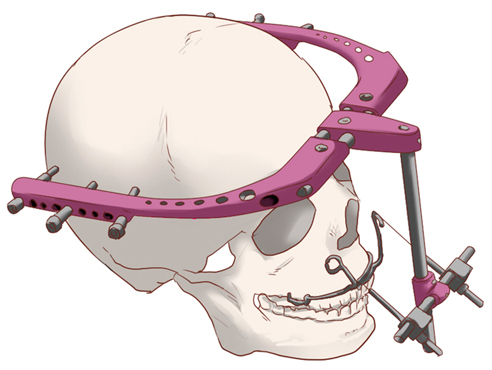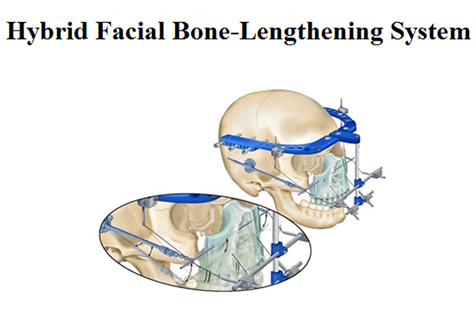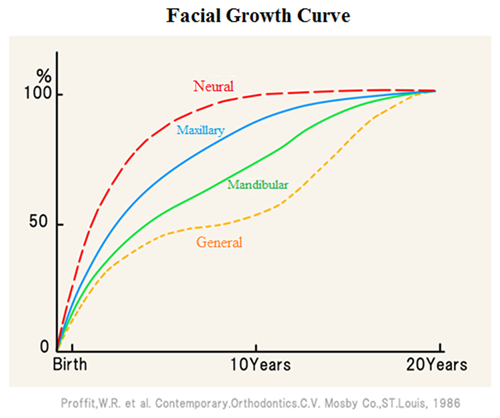【English】Minimally Invasive Procedures for Syndromic Craniosynostosis—Bone-lengthening Method using Two Types of Fixation Devices
Minimally Invasive Procedures for Syndromic Craniosynostosis—Bone-lengthening Method using Two Types of Fixation Devices
Syndromic craniosynostosis, in which the skull and facial bones do not grow due to congenital gene abnormalities, is an intractable disease that can cause problems with breathing, and with eating and drinking without treatment. Many patients have had to undergo multiple surgeries throughout their lifetime, but surgical procedures on the head and facial bones entail certain risks. For this reason, the Department of Plastic and Reconstructive Surgery, Kanagawa Children's Medical Center, has been working to develop and disseminate a facial bone-lengthening method that makes it possible to complete the treatment of syndromic craniosynostosis with a smaller number of surgeries. The advantages and disadvantages of typical surgical procedures for syndromic craniosynostosis and the most current treatments are as follows.
Necessity of Surgery for Syndromic Craniosynostosis
Syndromic craniosynostosis is the generic term for disorders in which the suture lines of the skull are fused due to congenital gene abnormalities and the growth of the skull and facial bones is inhibited.Since tissues other than bone tissues—such as those of the eyes and muscles as well as the brain—try to develop, inhibition of the growth of the skull and facial bones causes various symptoms such as protruding eyeballs and/or headaches and nausea due to increased brain pressure.
Absolute indications for surgery—difficulties in closing the eyes or breathing
The severity of symptomatic craniosynostosis varies. In severe cases where the eyelids cannot be closed, there is a risk of blindness due to corneal drying or dislocation of the eye (the eyeball may fall out of the orbit) unless the skull is enlarged by surgery.Failure of the maxilla to thrive can also result in a protruding lower jaw, which obstructs the upper airways, causing fatal respiratory problems. In such cases, a tracheostomy might need to be performed to ensure an open airway. If these are life-threatening symptoms, the bone-lengthening method is applied to enlarge the skull and facial bones. If there is no problem maintaining life, we decide upon a treatment plan after repeated explanations and consultations with parents.
What is the Bone-Lengthening Method for Syndromic Craniosynostosis?
Bone lengthening is a procedure in which, after an osteotomy is performed, a special device is used to slowly stretch the bones (calluses) in the healing process. This enables the facial bones, which have formed in a recessed low position, to be pulled out into a normal position.
Osteotomy Based on the Le Fort Classification—There are three main types of facial fractures.
Skull
If a skull is fractured for any reason, such as a fall or a traffic accident, the fracture may be basically classified as: (1) Le Fort I, (2) Le Fort II, or (3) Le Fort III. The Le Fort Classification, which was reported in 1905, has continued to be applied in plastic surgery until today.
Osteotomy can improve facial bone hypoplasia by considering the Le Fort I to III fracture lines according to the patient's facial appearance and occlusal conditions and by performing osteotomy.
Contrivances for preventing regression after osteotomy
From Autologous Bone Grafting to Traction Using Devices
In the past, osteotomy of the facial bones was performed, followed by autografting of the ilium to the osteotomy line to prevent regression. However, this approach did not allow access to the blood vessels, skin, or nerves. For this reason, changes in the position (height) of the bones often seemed to remain at around 1 cm.In particular, the skin of Japanese people tends to be harder to stretch than that of Caucasians. It is, therefore, presumed that the treatment of syndromic craniosynostosis by surgical procedures in the past would be difficult. To overcome these difficulties, we now use special lengthening devices to extend not only the bones but also the blood vessels, skin, and nerves after osteotomy. Pain is often very mild because the bones are slowly lengthened by 1 mm a day over time.
Bone-lengthening Method with External Device for Syndromic Craniosynostosis
The advantages of an external device is that the direction of extension of the bones can be controlled.
An external device used in surgery for syndromic craniosynostosis is one of the extending devices that pulls the upper jaw forward.

External Device
An external device, which fixes the skull percutaneously from outside the body, has the advantage of correcting the misalignment that occurs in the direction of bone lengthening. A major advantage of using this device is that it can control the direction in which the bones are extended.
Disadvantage of Bone-Lengthening Method with External Device—Weak Bone Extension Force
On the other hand, using an external device in a bone-lengthening method has a disadvantage in that the force applied to extend the bones is weak. That is because an external device tends to move when a strong force is applied to it. In addition, since the force applied to extend the bones is not strong, an external device is considered to provide only an improvement of about 2 cm in Japanese patients. As a result, patients need to have repeated surgeries as they grow.
Bone-lengthening Method with Internal Device for Syndromic Craniosynostosis
Advantage of Bone-Lengthening Method with Internal Device—Strong Force to Pull the Bones Forward
The advantage of bone lengthening using an internal device is that the force applied to pull the bones forward can be strong.
The bone-lengthening method used for syndromic craniosynostosis involves bone lengthening using an internal device. A fixation device inserted under the skin directly fixes to the skull. Bone lengthening using an internal device has the advantage that the force applied to push out the bones is stronger than when using an external device.
At our hospital, we have performed surgery to extend the bones by 2.5 cm at a time for a patient who had a risk of impaired respiratory function due to a lower jaw protrusion.
The disadvantage of bone lengthening using an internal device is that it is difficult to correct, and surgery is necessary even when it is removed.

Internal Device
It should be noted, however, that even a single misalignment of an internal device can have a major impact on the patient's facial formation. In addition, it is necessary to perform surgery that requires general anesthesia when the internal device is removed. For this reason, the bone-lengthening method using an external device is now often chosen.
Patients with syndromic craniosynostosis may have more than five surgeries during their lifetime.
Normal facial bone growth continues through the late teens.
To understand why multiple surgeries are needed throughout patients' lives, we need to understand normal skull and facial bone growth.
The facial bones usually continue to grow after the bones of the head have finished growing. The facial bones stop growing around the age of 18 in boys and between 16 and 17 in girls, and facial bone growth ends. Therefore, if a patient with syndromic craniosynostosis were to undergo surgery to pull out the bones to their normal position for a child aged around 6 before entering elementary school, the patient's bone would again become concaved by the time he or she were around 18 years of age.
For these reasons, the majority of patients have had at least one surgery on the head and, except for mild cases, three or more surgeries on the face, including surgery to align the maxilla and mandible.
However, surgery for syndromic craniosynostosis is so extensive as to require general anesthesia and blood transfusions, and the burden on the patient's mind, body and life is not small. Therefore, Kanagawa Children's Medical Center takes the following measures to reduce the number of surgeries performed on patients with syndromic craniosynostosis throughout their lives.
Developing a Hybrid Surgery for Syndromic Craniosynostosis

In our hospital, we have pioneered a bone-lengthening method using a newly developed internal fixation device together with an external device. Due to the use of two types of bone lengthening device, this method is sometimes referred to as "hybrid surgery" or "combined internal and external extenders."The extenders inserted under the skin can be moved in three dimensions, so that the angle of extension can be adjusted even if a subtle misalignment occurs after surgery. Removal of the extender only requires skin incision, with the procedure lasting about 30 minutes, so the amount of bleeding at the time of removal is greatly reduced and the degree of invasion is decreased greatly.The external device attached to the head can be removed nearly immediately after lengthening. Therefore, patients can leave the hospital quickly, live and play normally with a device that cannot be seen on the body surface.
We want to reduce the burden on patients by reducing the number of surgeries.
Necessity of Surgery for Syndromic Craniosynostosis
Using the newly developed method, one surgery allows bone lengthening by more than 3 cm.
With the birth of a technique that uses an external device and an extender for internal fixation, it has become possible to pull out the bones by more than 3 cm in a single operation. In our hospital, we use this technique to perform surgery to pull out patients' facial bones up to the height at the ages of 16 to 18. Pulling out the bones to a line for above the actual age is called "overcorrection." To minimize the functional problems and the uncomfortable appearance caused by overcorrection, it is necessary to shift the age at which surgery is performed to a later time than in traditional surgery.
If the patient's symptoms are relatively mild and he or she can wait for the initial surgery until after his or her teens, we recommend overcorrecting the bones between the ages of 16 and 18 before entering junior high school (around the age of 12). By pulling out the bones in the initial surgery to the position for the ages when the facial bones stop growing, facial surgery is more likely to be completed once in a patient's lifetime.

Advantages and Disadvantages of Hybrid Surgery for Syndromic Craniosynostosis
Patients who are assumed to have problems with eating or drinking due to misaligned bite caused by excessive bone extraction in a single facial surgery need to complete the lengthening before a problem arises. The use of two fixation devices increases the duration of surgery by 1 to 1.5 hours compared with the use of an external device alone.
Nevertheless, treating symptoms of syndromic craniosynostosis with fewer surgeries than before directly reduces the burden on the patient's body and life, and avoids the risks and complications of surgery. We also feel that having patients live a social life without repeated hospitalization during the later stages of puberty may have a positive impact on them.
Currently, this hybrid surgery is the only method of facial bone treatment for syndromic craniosynostosis that is likely to reduce the number of surgeries to complete treatment with a single surgery during the patient's lifetime. We have so far experienced no cases of regression.
We hope to provide the most suitable treatment for patients through close discussion with parents and cooperation with each clinical department treating the patients, such as pediatric internal medicine, neurosurgery, otolaryngology, and orthodontics.












